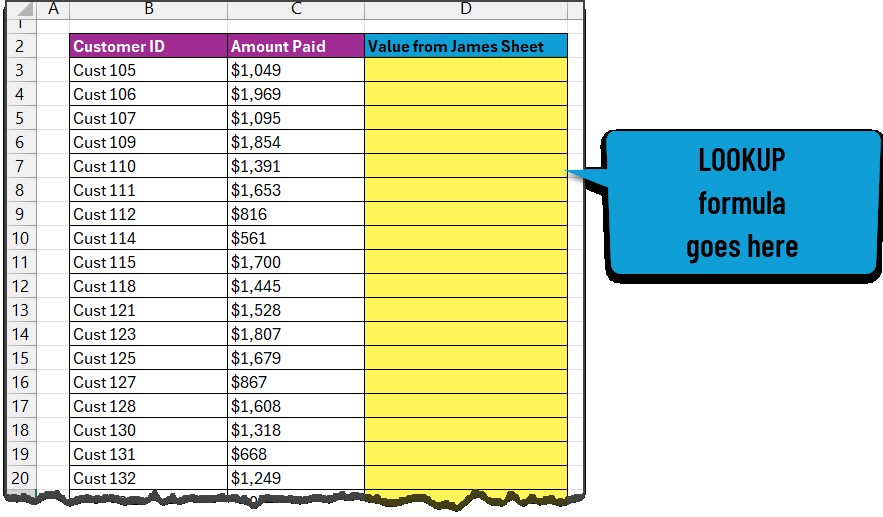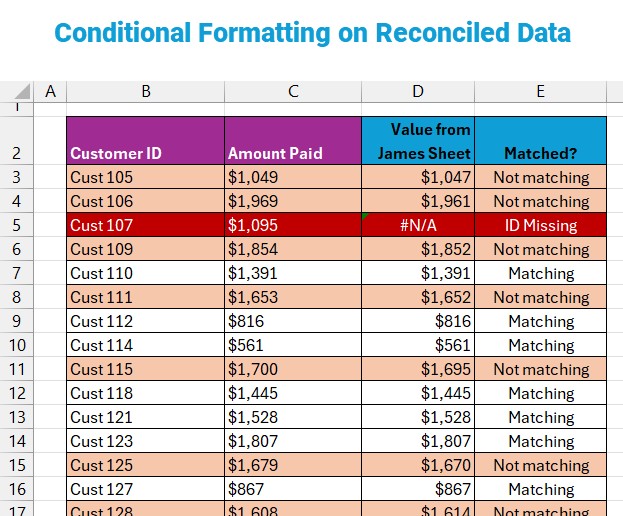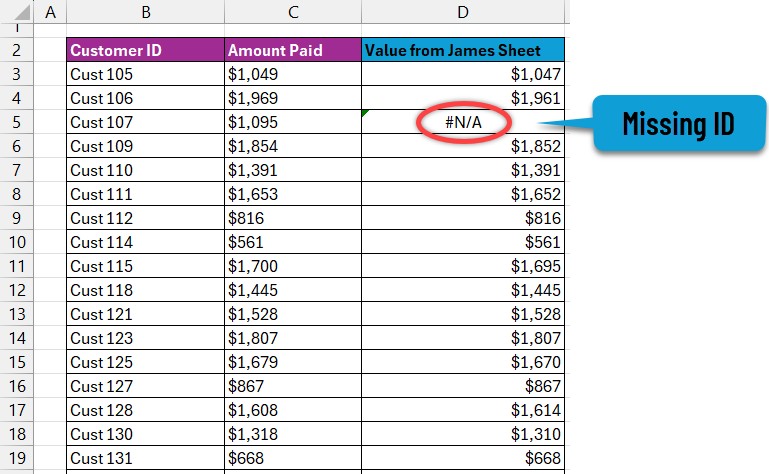VLOOKUP comparing two spreadsheets is a powerful technique for data reconciliation and analysis. At COMPARE.EDU.VN, we offer in-depth comparisons and guides to help you master these essential skills. This article will show you exactly how to compare data across two Excel sheets using VLOOKUP, and highlight when to use it, what to watch out for, and alternatives to consider. Learn about Excel comparison, spreadsheet comparison, and data reconciliation today.
1. Understanding the Need for Comparing Spreadsheets
In many professional scenarios, data is spread across multiple spreadsheets. Whether it’s customer lists, financial records, or inventory data, the ability to compare these sheets efficiently is crucial. This comparison allows you to identify discrepancies, reconcile data, and ensure accuracy. Spreadsheet comparison and data reconciliation are critical for informed decision-making.
1.1 Common Scenarios Requiring Spreadsheet Comparison
- Financial Audits: Comparing expense reports from different departments.
- Inventory Management: Reconciling stock levels between two warehouses.
- Customer Relationship Management (CRM): Identifying duplicate customer entries.
- Sales Analysis: Comparing sales data from different regions.
- Data Migration: Verifying data integrity after transferring information between systems.
1.2 Challenges in Manual Spreadsheet Comparison
Manually comparing two spreadsheets can be time-consuming and prone to errors. Here’s why:
- Scale: Large datasets make manual comparison impractical.
- Complexity: Spreadsheets with numerous columns and rows can be overwhelming.
- Human Error: Visual fatigue and distractions can lead to mistakes.
- Time Constraints: Manual comparison often delays critical decision-making processes.
1.3 Benefits of Automated Comparison Techniques
Automated comparison techniques, such as using VLOOKUP, provide significant advantages:
- Efficiency: Quickly compare large datasets with minimal effort.
- Accuracy: Reduce the risk of human error.
- Time Savings: Free up valuable time for more strategic tasks.
- Consistency: Ensure that comparisons are performed uniformly.
- Scalability: Easily adapt to increasing data volumes.
2. Introduction to VLOOKUP for Spreadsheet Comparison
VLOOKUP (Vertical Lookup) is a powerful Excel function that allows you to search for a specific value in a column and return a corresponding value from another column in the same row. When used creatively, VLOOKUP can be an invaluable tool for comparing data between two spreadsheets. Excel comparison using VLOOKUP offers a streamlined approach to data reconciliation.
2.1 Basic Syntax and Components of VLOOKUP
The VLOOKUP function has four main components:
lookup_value: The value you want to search for.table_array: The range of cells where you want to search and retrieve data.col_index_num: The column number in thetable_arrayfrom which to return a value.range_lookup: A logical value (TRUE or FALSE) that specifies whether you want an approximate or exact match.
Syntax:
=VLOOKUP(lookup_value, table_array, col_index_num, [range_lookup])2.2 How VLOOKUP Works in Principle
VLOOKUP searches for the lookup_value in the first column of the table_array. Once it finds a match (or the closest match, depending on the range_lookup setting), it moves to the col_index_num column in that row and returns the value found there. This makes it possible to extract relevant data from one sheet based on matching values in another.
2.3 Advantages and Limitations of Using VLOOKUP
Advantages:
- Simplicity: VLOOKUP is relatively easy to learn and use.
- Speed: It can quickly find matching values in large datasets.
- Flexibility: VLOOKUP can be used to compare various types of data.
Limitations:
- Directional Search: VLOOKUP only searches from left to right. The
lookup_valuemust be in the first column of thetable_array. - Single Match: VLOOKUP only returns the first match it finds.
- Error Handling: Can return
#N/Aerrors if thelookup_valueis not found.
3. Step-by-Step Guide: How to Use VLOOKUP Comparing Two Spreadsheets
Let’s walk through a detailed example of how to use VLOOKUP to compare two spreadsheets.
3.1 Setting Up Your Data
Before you start, ensure your data is well-organized. Here’s how:
- Open Excel: Launch Microsoft Excel and open the two spreadsheets you want to compare.
- Identify Common Column: Identify a column that is common between both sheets, such as Customer ID, Product Code, or Employee Number. This will be your
lookup_value. - Organize Data: Ensure that the common column is the leftmost column in the
table_arrayof the second sheet.
For example, let’s say you have two sheets: “SalesData_January” and “SalesData_February.” Both sheets contain a “ProductID” column and a “Revenue” column.
3.2 Writing the VLOOKUP Formula
-
Navigate to the First Sheet: Go to the first sheet (“SalesData_January”).
-
Insert a New Column: Insert a new column next to the “Revenue” column. Let’s name it “FebruaryRevenue.”
-
Enter the VLOOKUP Formula: In the first cell of the “FebruaryRevenue” column (e.g.,
C2), enter the VLOOKUP formula:=VLOOKUP(A2, 'SalesData_February'!A:B, 2, FALSE)A2: Thelookup_valueis the “ProductID” in the first sheet.'SalesData_February'!A:B: Thetable_arrayis the range containing the “ProductID” and “Revenue” columns in the second sheet.2: Thecol_index_numis 2 because the “Revenue” is in the second column of thetable_array.FALSE: Specifies that you want an exact match.
-
Apply the Formula: Drag the fill handle (the small square at the bottom-right of the cell) down to apply the formula to all rows in the column.
3.3 Understanding the Formula and Its Components
Let’s break down the VLOOKUP formula:
VLOOKUP(A2, 'SalesData_February'!A:B, 2, FALSE)A2: This is thelookup_value. In our example, it’s the “ProductID” in the current row of “SalesData_January.”'SalesData_February'!A:B: This is thetable_array. It specifies the range of cells in “SalesData_February” where VLOOKUP will search for the “ProductID” and retrieve the corresponding “Revenue.”2: This is thecol_index_num. It tells VLOOKUP to return the value from the second column of thetable_array(i.e., the “Revenue” column).FALSE: This ensures that VLOOKUP looks for an exact match of thelookup_value. If an exact match is not found, it returns an#N/Aerror.
3.4 Handling #N/A Errors
If VLOOKUP can’t find a match for the lookup_value, it returns an #N/A error. Here’s how to handle these errors:
-
Using IFERROR: Wrap the VLOOKUP formula with the
IFERRORfunction to display a more user-friendly message.=IFERROR(VLOOKUP(A2, 'SalesData_February'!A:B, 2, FALSE), "Not Found")This formula will display “Not Found” if VLOOKUP returns an
#N/Aerror. -
Identifying Missing Values: Use the
ISNAfunction to identify rows with#N/Aerrors.=ISNA(C2)This formula will return
TRUEif cellC2contains an#N/Aerror, andFALSEotherwise. -
Conditional Formatting: Use conditional formatting to highlight cells with
#N/Aerrors.- Select the “FebruaryRevenue” column.
- Go to “Home” > “Conditional Formatting” > “New Rule.”
- Select “Use a formula to determine which cells to format.”
- Enter the formula
=ISNA(C2). - Click “Format” and choose a highlight color.
- Click “OK” to apply the formatting.
3.5 Comparing Values with the IF Function
Now that you have the “FebruaryRevenue” in the first sheet, you can compare it with the “Revenue” from January using the IF function:
-
Insert a New Column: Insert a new column next to the “FebruaryRevenue” column. Let’s name it “RevenueComparison.”
-
Enter the IF Formula: In the first cell of the “RevenueComparison” column (e.g.,
D2), enter the IF formula:=IF(C2=B2, "Match", "Mismatch")C2: The “FebruaryRevenue” value.B2: The “Revenue” value from January."Match": The result if the values are the same."Mismatch": The result if the values are different.
-
Apply the Formula: Drag the fill handle down to apply the formula to all rows in the column.
3.6 Highlighting Differences Using Conditional Formatting
To quickly identify discrepancies, use conditional formatting:
- Select the “RevenueComparison” Column: Select the entire “RevenueComparison” column.
- Go to Conditional Formatting: Go to “Home” > “Conditional Formatting” > “New Rule.”
- Use a Formula: Select “Use a formula to determine which cells to format.”
- Enter the Formula: Enter the formula
=$D2="Mismatch". - Set the Format: Click “Format,” choose a highlight color (e.g., red), and click “OK.”
- Apply the Rule: Click “OK” to apply the conditional formatting rule.
Now, all cells in the “RevenueComparison” column that contain “Mismatch” will be highlighted in red, making it easy to spot discrepancies.
4. Advanced VLOOKUP Techniques for Complex Comparisons
While basic VLOOKUP is useful, advanced techniques can handle more complex comparison scenarios.
4.1 Using VLOOKUP with Multiple Criteria
Sometimes, a single column isn’t enough to uniquely identify a record. In such cases, you can combine multiple columns into a single lookup value.
-
Create a Helper Column: In both sheets, create a new column that concatenates the values from the multiple columns.
=A2&"_"&B2This formula combines the values from columns A and B, separated by an underscore.
-
Use the Helper Column in VLOOKUP: Use the helper column as the
lookup_valuein your VLOOKUP formula.=VLOOKUP(C2, 'SalesData_February'!C:D, 2, FALSE)Here,
C2is the helper column in the first sheet, and'SalesData_February'!C:Dis the range containing the helper column and the value you want to retrieve in the second sheet.
4.2 Combining VLOOKUP with Other Functions (e.g., MATCH, INDEX)
Combining VLOOKUP with other functions like MATCH and INDEX can overcome some of its limitations.
-
Using INDEX and MATCH: The
INDEXandMATCHfunctions provide a more flexible alternative to VLOOKUP. They can search in any direction and return values from any column.=INDEX('SalesData_February'!B:B, MATCH(A2, 'SalesData_February'!A:A, 0))'SalesData_February'!B:B: The column from which to return the value (Revenue).MATCH(A2, 'SalesData_February'!A:A, 0): Finds the row number where thelookup_value(ProductID) is found in thelookup_array.0: Specifies an exact match.
4.3 Using Array Formulas for More Complex Logic
Array formulas can perform calculations on multiple values at once, allowing for more complex comparisons.
-
Enter the Array Formula: Enter the array formula in a cell. For example, to compare the “Revenue” values for matching “ProductID” entries, you can use:
=SUM(IF('SalesData_January'!A2:A100='SalesData_February'!A2:A100, ABS('SalesData_January'!B2:B100-'SalesData_February'!B2:B100), 0))This formula calculates the sum of the absolute differences in “Revenue” between the two sheets for matching “ProductID” entries.
-
Enter as Array Formula: Press
Ctrl + Shift + Enterto enter the formula as an array formula. Excel will automatically add curly braces{}around the formula.
5. Alternatives to VLOOKUP for Spreadsheet Comparison
While VLOOKUP is a useful tool, several alternatives offer different strengths and may be more suitable for certain scenarios.
5.1 XLOOKUP: A Modern Alternative
XLOOKUP is a more modern function available in Excel 365 and later versions. It addresses many of the limitations of VLOOKUP and HLOOKUP.
-
Syntax:
=XLOOKUP(lookup_value, lookup_array, return_array, [if_not_found], [match_mode], [search_mode]) -
Advantages:
- Flexibility: Can search in any direction.
- Error Handling: Built-in
if_not_foundargument to handle missing values. - Performance: Often faster than VLOOKUP.
5.2 Power Query: Excel’s Data Transformation Tool
Power Query (also known as Get & Transform Data) is a powerful tool for importing, transforming, and combining data from multiple sources.
-
Steps to Compare with Power Query:
- Import Data: Import both spreadsheets into Power Query.
- Merge Queries: Use the “Merge Queries” feature to combine the data based on a common column.
- Expand Columns: Expand the columns you want to compare.
- Compare Values: Add a custom column to compare the values using an
IFstatement.
-
Advantages:
- Data Cleaning: Can handle messy data and perform transformations.
- Automation: Can automate the comparison process.
- Scalability: Suitable for large datasets.
5.3 Dedicated Comparison Software
Several dedicated software solutions are designed specifically for comparing spreadsheets.
-
Examples:
- Araxis Merge: A professional tool for comparing and merging files.
- Beyond Compare: A multi-platform utility for comparing files and folders.
- Spreadsheet Compare: A tool designed specifically for Excel spreadsheets.
-
Advantages:
- Advanced Features: Offer more advanced comparison features, such as highlighting differences and merging changes.
- Version Control: Some tools integrate with version control systems.
- Reporting: Generate detailed comparison reports.
5.4 Comparison of Different Methods
| Method | Advantages | Limitations | Use Case |
|---|---|---|---|
| VLOOKUP | Simple, quick, easy to learn | Directional, single match, error handling required | Small to medium datasets, simple comparisons |
| XLOOKUP | Flexible, handles errors, performance | Requires Excel 365 or later | Modern Excel users, more complex comparisons |
| Power Query | Data cleaning, automation, scalability | Steeper learning curve | Large datasets, complex transformations, automated comparisons |
| Dedicated Software | Advanced features, version control, reporting | Costly, may require training | Professional environments, complex comparison needs, version control |



6. Best Practices for Spreadsheet Comparison
To ensure accurate and efficient spreadsheet comparison, follow these best practices.
6.1 Data Preparation and Cleaning
- Consistency: Ensure data is consistent across both sheets. Use the same formatting, naming conventions, and data types.
- Remove Duplicates: Remove any duplicate entries that could skew the comparison.
- Handle Missing Values: Decide how to handle missing values. Replace them with a placeholder or exclude them from the comparison.
- Trim Whitespace: Remove any leading or trailing whitespace from text values.
6.2 Ensuring Data Integrity
- Validation: Validate data to ensure it meets certain criteria. Use data validation rules to restrict the types of values that can be entered in a cell.
- Audit Trails: Keep track of changes made to the data. Use Excel’s “Track Changes” feature or create a custom audit trail.
- Backup: Regularly back up your spreadsheets to prevent data loss.
6.3 Automating the Comparison Process
- Macros: Use Excel macros to automate repetitive tasks. Write a macro to perform the comparison steps automatically.
- Power Automate: Integrate Excel with Power Automate to create automated workflows. Set up triggers to automatically compare spreadsheets when they are updated.
- Scheduled Tasks: Use Windows Task Scheduler or similar tools to schedule the comparison process to run automatically at regular intervals.
7. Common Pitfalls and How to Avoid Them
Even with the best techniques, certain pitfalls can hinder accurate spreadsheet comparison.
7.1 Incorrect Range References
- Problem: Using incorrect range references in your formulas can lead to inaccurate results.
- Solution: Double-check your range references to ensure they are correct. Use absolute references (
$A$1) to prevent ranges from changing when you copy the formula.
7.2 Mismatched Data Types
- Problem: Comparing data with different data types (e.g., text vs. number) can lead to unexpected results.
- Solution: Ensure that the data types are consistent across both sheets. Use Excel’s “Format Cells” dialog to change the data type of a cell or column.
7.3 Hidden Rows or Columns
- Problem: Hidden rows or columns can be unintentionally excluded from the comparison.
- Solution: Unhide all rows and columns before performing the comparison. Go to “Home” > “Format” > “Hide & Unhide” and select “Unhide Rows” and “Unhide Columns.”
7.4 Case Sensitivity
-
Problem: VLOOKUP is not case-sensitive by default. This can lead to incorrect matches if the
lookup_valuehas different capitalization in the two sheets. -
Solution: Use the
EXACTfunction to perform a case-sensitive comparison. Combine it with anIFstatement to return a “Match” or “Mismatch” result.=IF(EXACT(A2, 'SalesData_February'!A2), "Match", "Mismatch")
8. Real-World Examples of VLOOKUP in Action
To illustrate the practical applications of VLOOKUP, let’s look at some real-world examples.
8.1 Financial Audits: Comparing General Ledger Data
In financial audits, it’s common to compare general ledger data from different periods or systems. VLOOKUP can be used to match transactions based on transaction IDs and identify any discrepancies in amounts or descriptions.
8.2 Inventory Management: Reconciling Stock Levels
Inventory managers often need to reconcile stock levels between different warehouses or systems. VLOOKUP can be used to match products based on product codes and identify any differences in quantity.
8.3 Customer Relationship Management (CRM): Identifying Duplicate Contacts
In CRM systems, it’s important to identify and merge duplicate contacts. VLOOKUP can be used to match contacts based on email addresses or phone numbers and identify any duplicate entries.
8.4 Sales Analysis: Comparing Sales Performance Across Regions
Sales analysts often need to compare sales performance across different regions or channels. VLOOKUP can be used to match products based on product codes and compare sales revenue, units sold, or profit margins.
9. FAQs About Using VLOOKUP for Spreadsheet Comparison
To further clarify the use of VLOOKUP for spreadsheet comparison, here are some frequently asked questions:
-
Can VLOOKUP compare data in two different Excel files?
-
Yes, VLOOKUP can compare data in two different Excel files. You need to include the file name in the
table_arrayargument. For example:=VLOOKUP(A2, '[SalesData_February.xlsx]Sheet1'!A:B, 2, FALSE)
-
-
How do I compare multiple columns using VLOOKUP?
- You can use multiple VLOOKUP formulas to compare multiple columns. Alternatively, you can combine the columns into a single helper column and use that as the
lookup_value.
- You can use multiple VLOOKUP formulas to compare multiple columns. Alternatively, you can combine the columns into a single helper column and use that as the
-
How do I handle different row orders in the two spreadsheets?
- VLOOKUP doesn’t require the rows to be in the same order. It searches for the
lookup_valuein thetable_arrayregardless of the row order.
- VLOOKUP doesn’t require the rows to be in the same order. It searches for the
-
What are the limitations of VLOOKUP when comparing large datasets?
- VLOOKUP can be slow when comparing large datasets. In such cases, consider using XLOOKUP, Power Query, or a dedicated comparison software.
-
Can I use VLOOKUP to compare data in Google Sheets?
- Yes, VLOOKUP is also available in Google Sheets and works similarly to Excel.
-
How do I compare two columns in the same spreadsheet?
-
You don’t need VLOOKUP to compare two columns in the same spreadsheet. You can use a simple
IFformula:=IF(A2=B2, "Match", "Mismatch")
-
-
How do I compare two spreadsheets with different structures?
- Comparing spreadsheets with different structures can be challenging. You may need to use Power Query to transform the data into a common structure before performing the comparison.
-
What is the difference between VLOOKUP and HLOOKUP?
- VLOOKUP searches vertically (in columns), while HLOOKUP searches horizontally (in rows). Use VLOOKUP when the
lookup_valueis in the first column of thetable_array, and HLOOKUP when thelookup_valueis in the first row of thetable_array.
- VLOOKUP searches vertically (in columns), while HLOOKUP searches horizontally (in rows). Use VLOOKUP when the
-
How do I compare data based on partial matches?
- VLOOKUP can perform partial matches if you set the
range_lookupargument toTRUE. However, this is not recommended for accurate comparisons. Instead, consider using theSEARCHorFINDfunctions to identify partial matches.
- VLOOKUP can perform partial matches if you set the
-
How do I compare data based on date ranges?
-
To compare data based on date ranges, you can use a combination of
IFandANDfunctions along with VLOOKUP. For example, if you want to check if a date falls within a specific range and then compare values, you can use:=IF(AND(A2>=Date1, A2<=Date2), VLOOKUP(…), “Out of Range”)Replace
Date1andDate2with the start and end dates of your range.
-
10. Leverage COMPARE.EDU.VN for Comprehensive Comparisons
COMPARE.EDU.VN is your go-to resource for comprehensive and objective comparisons across a wide range of topics. Whether you’re evaluating products, services, or educational resources, our platform offers detailed analyses to help you make informed decisions.
10.1 Why Choose COMPARE.EDU.VN?
- Objective Comparisons: We provide unbiased comparisons based on thorough research and analysis.
- Detailed Information: Access in-depth information, including features, specifications, pricing, and user reviews.
- User-Friendly Interface: Our platform is designed to be intuitive and easy to navigate, allowing you to quickly find the comparisons you need.
- Wide Range of Categories: From technology and finance to education and lifestyle, we cover a diverse range of categories to meet your comparison needs.
10.2 How COMPARE.EDU.VN Can Help You Make Informed Decisions
- Product Comparisons: Compare the features, specifications, and prices of different products to find the best option for your needs and budget.
- Service Evaluations: Evaluate the services offered by different providers, including their pricing, terms, and customer support.
- Educational Resource Reviews: Compare different educational resources, such as online courses, textbooks, and learning platforms, to find the best fit for your learning style and goals.
10.3 Explore Our Comparison Categories
Visit COMPARE.EDU.VN to explore our comparison categories and discover the insights you need to make confident decisions. Our platform is continuously updated with new comparisons and reviews to provide you with the latest information.
Conclusion
Using VLOOKUP to compare two spreadsheets is a valuable skill for anyone working with data in Excel. Whether you’re performing financial audits, managing inventory, or analyzing sales data, VLOOKUP can help you quickly identify discrepancies and ensure accuracy. By following the steps outlined in this guide, you can master VLOOKUP and streamline your spreadsheet comparison tasks. And remember, for comprehensive and objective comparisons, visit COMPARE.EDU.VN to make informed decisions.
Ready to take your spreadsheet comparison skills to the next level? Visit COMPARE.EDU.VN today to explore more resources and tools. Our platform offers detailed comparisons, expert reviews, and user feedback to help you make the best decisions for your needs. Don’t leave your choices to chance – let COMPARE.EDU.VN guide you to success.
For more information, contact us at:
Address: 333 Comparison Plaza, Choice City, CA 90210, United States
WhatsApp: +1 (626) 555-9090
Website: compare.edu.vn
